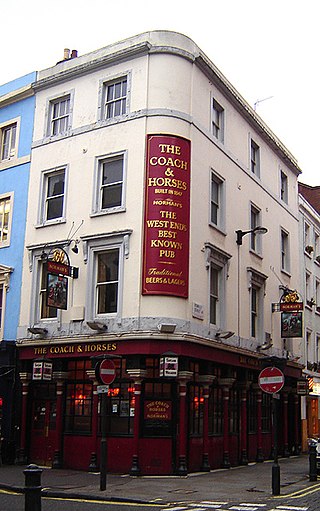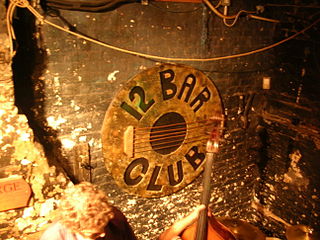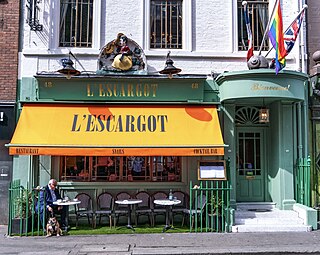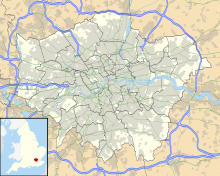
Soho is an area of the City of Westminster in the West End of London. Originally a fashionable district for the aristocracy, it has been one of the main entertainment districts in the capital since the 19th century.

Wardour Street is a street in Soho, City of Westminster, London. It is a one-way street that runs north from Leicester Square, through Chinatown, across Shaftesbury Avenue to Oxford Street. Throughout the 20th century the West End street became a centre for the British film industry and the popular music scene.

Old Compton Street is a road that runs east–west through Soho in the West End of London, named after Henry Compton who raised funds for St Anne's Church in 1686. The area, particularly this street, became home to French Protestant refugees in 1681. Known for its diverse and artistic traditions, the street housed businesses, artists, philosophers, and was frequented by communists and proto-beatniks. The Algerian Coffee Stores, one of the oldest shops on the street, was established in 1887. Post World War II, the street became a center for modern and trad jazz. Since the 1970s, Old Compton Street has been a focal point for London's gay community, with numerous gay bars, restaurants, and specialty shops. The Admiral Duncan pub, a notable gay venue, was bombed in 1999 in a hate crime attack. The street is also home to the Prince Edward Theatre.

Soho Square is a garden square in Soho, London, hosting since 1954 a de facto public park let by the Soho Square Garden Committee to Westminster City Council. It was originally called King Square after Charles II, and a much weathered statue of the monarch has stood in the square, with an extended interruption, since 1661, one year after the restoration of the monarchy.

The Coach and Horses at 29 Greek Street on the corner with Romilly Street in Soho, London, is a grade II listed public house.

Coventry Street is a short street in the West End of London, connecting Piccadilly Circus to Leicester Square. Part of the street is a section of the A4, a major road through London. It is named after the politician Henry Coventry, secretary of state to Charles II.

A Tale of Two Cities is a historical novel published in 1859 by English author Charles Dickens, set in London and Paris before and during the French Revolution. The novel tells the story of the French Doctor Manette, his 18-year-long imprisonment in the Bastille in Paris, and his release to live in London with his daughter Lucie whom he had never met. The story is set against the conditions that led up to the French Revolution and the Reign of Terror.

Frith Street is in the Soho area of London. To the north is Soho Square and to the south is Shaftesbury Avenue. The street crosses Old Compton Street, Bateman Street and Romilly Street.

Bar Hercules, historically the Pillars of Hercules, was a pub in Greek Street, Soho, London, originally named for the Pillars of Hercules of antiquity. Most of what exists was built around 1910, but the pub dates back to 1733. The road at the side of the pub through the arch is named Manette Street, after Dr Manette, one of the characters from A Tale of Two Cities, who is described in the book as living near Soho Square.

The 12 Bar Club was a music venue in London that opened in 1994 on Denmark Street – known as Britain's "Tin Pan Alley" – just off Charing Cross Road and close to Soho.
Les Cousins was a folk and blues club in the basement of a restaurant in Greek Street, in the Soho district of London, England. It was most prominent during the British folk music revival of the mid-1960s and was known as a venue where musicians of the era met and learnt from each other. As such, it was influential in the careers of, for example, Jackson C. Frank, Al Stewart, Marc Brierley, Davey Graham, Bert Jansch, John Renbourn, Sandy Denny, John Martyn, Alexis Korner, The Strawbs, Roy Harper, The Young Tradition and Paul Simon. Several albums were recorded there.

The Gay Hussar was a celebrated Hungarian restaurant located at 2 Greek Street, Soho, central London, England. It was established in 1953 and closed in 2018.

L'Escargot is London's oldest French restaurant, and is also one of the city's oldest restaurants. It is housed in a Georgian townhouse on Greek Street, in the heart of the Soho district. The building, which dates from 1741, was previously the private residence of the Duke of Portland.

The House of St Barnabas, at 1 Greek Street, Soho, is a Grade I Listed Georgian building in London notable for its rococo plasterwork interiors and for other architectural features.
Carlisle House was the name of two late seventeenth-century mansions in Soho, London, on opposite sides of Soho Square. One, at the end of Carlisle Street, is sometimes incorrectly said to have been designed by Christopher Wren; it was destroyed in the Blitz. The other was the location of Madame Cornelys' entertainments in the eighteenth century and was demolished in 1791; part of the site was cleared in 1891 for the building of St. Patrick's church.
Jimmy Lahoud is a Lebanese businessman and restaurateur in London, England. He has owned restaurants such as Quo Vadis, L'Escargot, and Café St. Pierre. Lahoud is an art collector, displaying his Picasso, Miró, Chagall, Warhol and Matisse pieces in at least one of his restaurants. Lahoud is credited for launching the career of celebrity chef Marco Pierre White. With White, Lahoud established White Star Line Ltd, which owned the Belvedere Restaurant.
Benugo (benúːgoʊ) is a British catering company. It operates high street cafes, restaurants, dining spaces inside public buildings as well as in-house corporate cafes. As of March 2014, Benugo had more than 70 individual locations; most of these are in London, with some locations outside including Bath, Oxford, Coventry, Edinburgh and Stirling.

Maison Bertaux is a French pâtisserie in Greek Street, Soho, London. The shop began in 1871, making it the oldest pâtisserie in London.

Manette Street is a small street in the Soho area of London, linking the Charing Cross Road to Greek Street. Dating from the 1690s, and formerly named Rose Street, it is now named after the fictional character of Dr Manette in Charles Dickens's A Tale of Two Cities, who is described in the book as living on a quiet street corner "not far from Soho Square".

















